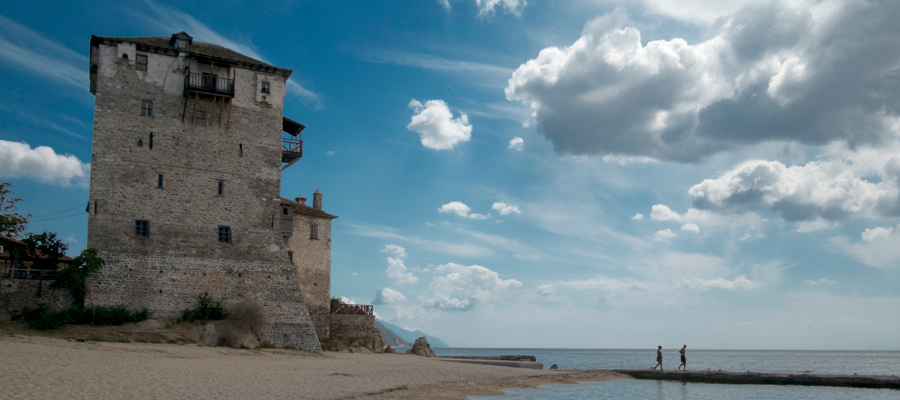The tower of Prosforio
The birds flying around and the fishermen fixing their nets near the pier perfectly match the picture of the lonely, high tower located on the sand. The symbol of Ouranoupoli, the last “postcard” everyone boarding the ship to Mount Athos takes with him, seems to exist there since the 12th century and is the largest and best preserved tower in Halkidiki. The complex consists of the byzantine tower, the small, fortified yard called “barbakas” and the “arsanas” (port) of 1865.
It belonged to the dependency of Prosforion (today’s Ouranoupoli) the original core of which already belonged to the Vatopediou monastery in 1018. Scattered information regarding what happened to the building is found from sources, since the excavations are not yet finished. It is known that in 1379, the despot of Thessaloniki named John Palaiologos was hosted here, that in an earthquake in 1585 it suffered great damage and that in 1858 it was abandoned –a picture commonly seen at that time in Halkidiki. In addition, it was probably burned in 1821, since there are testimonies that in 1858 it was in a terrible condition and abandoned. Its current form came from the extensive repair and reconstruction that followed.
In 1924, after the exchange of population, refuges from Asia Minor settled in the dependencies and founded Ouranoupoli. Several houses were built over time and gradually joined the building set. In 1928, the couple Joice and Sydney Loch came as members of humanitarian groups. They settled in the tower and offered essential help to the refuges and the victims of the 1932 earthquake.
STRUCTURAL-HISTORICAL PHASES
The building has been through at least three main structural-historical phases. The byzantine phase (11th-12th century) includes the lower building without the two floors. In the next phase, dated during the Ottoman rule and probably after the 1585 earthquake, three more floors were added, two of which are preserved until present day. The third floor might have been another level of battlements. The inner wood paneling of the building and the roof, preserved until present day were built in the third phase, and were included in the reconstruction that finished in 1862. The external oblique retaining wall (called skarpas), was built after the reconstruction.
The “barbakas”, i.e. the fortified perimeter, is attached to the eastern side of the tower that seems to be an addition during the early Ottoman rule, with subsequent repairs. The accommodation and storage spaces inside barbakas were designated in the middle 19th century. Arsanas (harbor) is located northwest of the tower, and was built in 1865 together with a pier that nowadays does not exist. It consists of the semi basement storage of the dependency’s boat, the warehouses in the semi upper floor and the upper floor. There were also other buildings: warehouses, barns, olive mills, wells. Nowadays only the “halkadio” and the “kolligadiko” located a little farther, are preserved.
THE LOCHS
The Australian writer and journalist Joice NanKivelli treveled to Europe to report the events of the 1st world war. In 1919, she married Scotish journalist and writer Sydney Loch and together they continued traveling and settling in several countries of the world offering humanitarian help (they belonged to the religious group of Kouakers, or Christian Friends). In one of their journeys, they went to Thessaloniki and from there to Ouranoupoli. In 1928, they decided to settle, initially in the island of Ammouliani and then to the Prosforiou tower that charmed them.
Older people still remember them, they talk about the ”Madam” and Sydney, for helping them during the difficult times after the 1932 earthquake, for the way they used to run around all day long, distributing drugs to the refuges, for how they used to take their lanterns at night and visit people in need. Their largest contribution was the preservation of the traditional patterns of handmade textiles. Sydney designed based on patterns from murals of Mount Athos and Persian carpets. Joice showed how to naturally color the wool, to the already experienced with weaving, women of the Asia Minor refuges. They both passed away in Ouranoupoli, Sydney in 1954 and Joice in 1982 at the age of 95.






